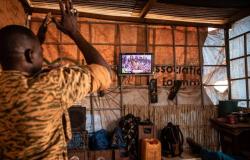A child who is seriously injured, covered in dust and blood, and brought lifeless into a hospital by a helpless parent in Gaza. A woman in Israel who is taken away by members of Hamas on October 7, screaming for help.
Intense images
While videos from news media or television broadcasts warn you in advance of potentially shocking images to come, you are regularly unintentionally confronted with violent images on social media.
In the case of the war between Israel and Hamas, people who share the images often have a goal: according to media scientists, they want their followers to understand how bad what is happening there is, and that the conflict must end as quickly as possible. The unpleasant images reinforce their opinion.
British Carlotta (33) regularly shares intense images from the war on her social media. In her case it mainly concerns images from Gaza. “It’s one of the few things I can do,” she explains to RTL News. “I want to show what the mainstream media doesn’t show.”
Blood and dead people
She goes far in this: dead children with missing body parts, blood and open wounds, bodies that are recovered. “I initially added warnings to the images before sharing them, but I stopped doing that. It should be normal for us to feel uncomfortable about this.”
Carlotta recently posted a video on Instagram showing a badly damaged corpse being pulled from the rubble in Gaza:
“I try to focus mainly on the humanitarian side, and not the political side,” she says. “In an effort to appeal to everyone’s humanity. Ultimately, we are all powerless. I hope that through these images, people will take the time to educate themselves.”
‘New front in the war’
Esther Hammelburg, media scientist at the Amsterdam University of Applied Sciences, thinks it is good to explain that people spread violent images from the war. “Social media is a way to express our feelings. We show our desperation, but we also highlight a perspective that you feel is underexposed.”
The scientist does say that it is very important that people are aware of where certain information comes from. Recently, Hammelburg, together with researcher Marloes Geboers, called for restraint in sharing images from the conflict area. “Think carefully about what you share.” People would unconsciously contribute to the conflict. In Het Parool they stated that ‘a new front in the war is emerging on our social media’.
“We call that participatory propaganda,” Hammelburg explains the call. “Propaganda is communication with the aim of changing your behavior or thinking, that is also happening in this war. On social media you are not only the recipient, but also the creator. You share, you like, you respond. The risk is that you unknowingly participate in propaganda.”
According to Hammelburg, these are different types of posts. Sometimes it concerns intense images, such as videos of Israeli hostages or injured Palestinian children, with a strong guiding text.
‘Slideshow activism, educate yourself and debunking posts’
“You also see a lot of so-called ‘slideshow activism’ on Instagram. This is a series of tiles with text in which information is given or an argument is made. This often concerns information that the person posting it believes is not seen enough, it is assumed that most people do not know, or in which information is debunked from another position.”
This way you consciously share images from the war
Esther Hammelburg gives tips on how you can consciously share photos and videos from the war on social media.
- Realize that you contribute to a certain image of the situation.
- Don’t just post anything. Choose consciously: which images do I share, which images do I not share.
- Check where the content comes from. Could the video shared by a friend come from a politically controlled party?
- Ask yourself what effect this image has on your followers. Would you also show this to people on a birthday?
- Do a final check: does this image match what I want to say to my followers?
In addition, the call ‘educate yourself’ is also widely circulated, says Hammelburg. “Specific information is then given that is often highly colored or one-sided. There are also videos that are cynically critical of Israelis or Palestinians, for example videos of Israeli soldiers doing dances that imply that the war is fun for them. “
Then, according to the media scientist, there are the so-called ‘debunking posts’, for example the so-called unmasking that a photo of Palestinian victims was staged. “These types of unmasking messages are often incorrect and are regularly deliberately spread to sow doubt or discredit a party.”
Also positive propaganda
By the way, propaganda certainly does not always have to be negative. “You can also want to change people’s thinking in a positive way. A campaign to take good care of your teeth is also propaganda. But we see that as positive.”
Propaganda can also be positive in a war situation, although that field of tension is a lot thinner, says Hammelburg. “I also see that it is polarizing very quickly online, and that the conflict is therefore being brought here.”
“The news about the war and all the posts on social media touch the sensitivities of many people. Especially among Jews and Muslims who feel less heard and understood in the Netherlands. People feel sad, angry and regularly even unsafe because of the extreme content that see them around.”
Comments and unfollows
Carlotta noticed this too when she started posting the images. Not all her followers can appreciate the videos and photos. “I received a lot of reactions in the beginning and I was also unfollowed by some. I was also afraid that my Jewish friends, whom I love, would find me anti-Semitic because of the images I spread from Gaza. Some also react negatively to it .But I know who I am, and I am not anti-Semitic.”
That’s why it’s not such a bad idea to put down that phone every now and then, Hammelburg thinks. Watch less, share less. “It is very wise to occasionally focus on the physical world around you.” Because you can also do something offline with your sadness or anger about the conflict between Israel and Hamas. “Think of demonstrating or donating money.”






